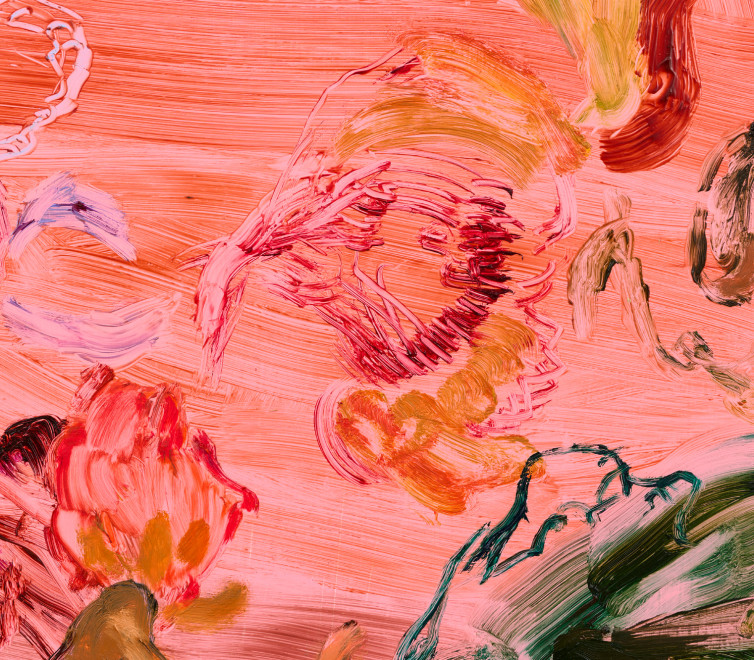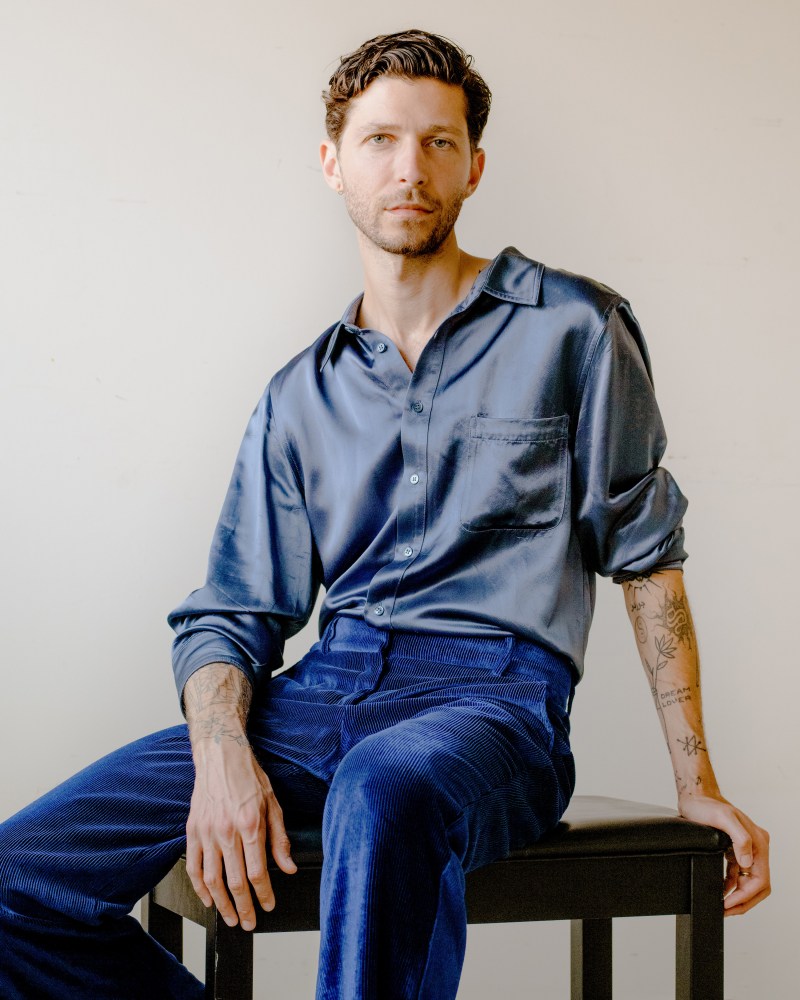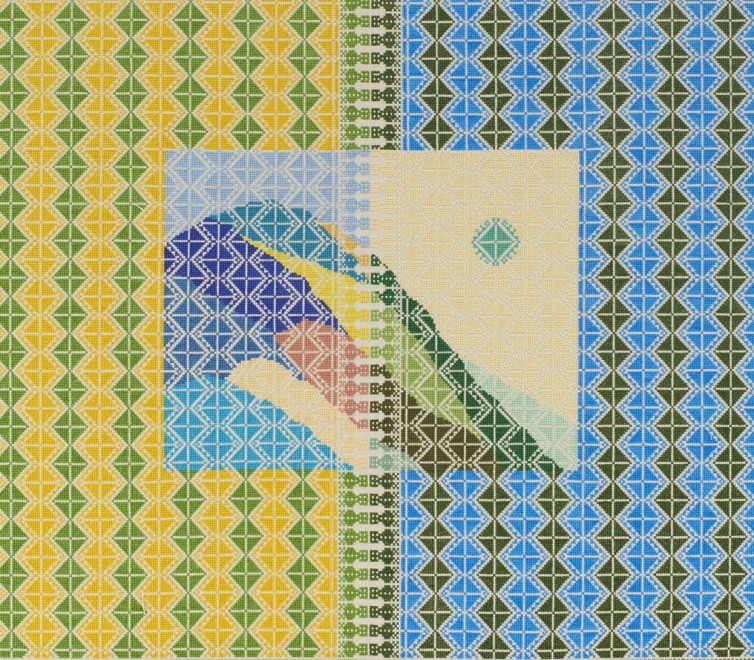
JORDAN NASSAR
Song of the Flowers, 2022
Hand-embroidered cotton on cotton
130 x 245 x 1 in.
330.2 x 622.3 x 2.5 cm
JCG13688
JORDAN NASSAR
Lament of the Field, 2022
Hand-embroidered cotton on cotton
130 x 245 x 1 in.
330.2 x 622.3 x 2.5 cm
JCG13689
Installation view, Jordan Nassar: Fantasy and Truth, the Institute of Contemporary Art/Boston, 2022–2023. Photo by Mel Taing.
Installation view, Jordan Nassar: Fantasy and Truth, the Institute of Contemporary Art/Boston, 2022–2023. Photo by Mel Taing.
Installation view, Jordan Nassar: Fantasy and Truth, the Institute of Contemporary Art/Boston, 2022–2023. Photo by Mel Taing.
JORDAN NASSAR
A Mountain Looms, 2023
Hand-embroidered cotton on cotton
84 x 84 x 1 in.
213.4 x 213.4 x 2.5 cm
JCG15002
JORDAN NASSAR
Closer to the Sky, 2023
Hand-embroidered cotton on cotton
60 x 84 x 1 in.
152.4 x 213.4 x 2.5 cm
JCG15004
JORDAN NASSAR
Beyond the Boundaries, 2022
hand-embroidered cotton on cotton
84 x 81 x 1 in.
213.4 x 205.7 x 2.5 cm
JCG13301
JORDAN NASSAR
Brick Walls and Closed Windows, 2022
hand-embroidered cotton on cotton
93 x 86 x 1 in.
236.2 x 218.4 x 2.5 cm
JCG13302
JORDAN NASSAR
Divorce Of The Doves, 2022
hand-flamed glass beads, steel, wire
21 1/4 x 49 1/4 x 1 3/4 in.
54 x 125.1 x 4.4 cm
JCG13439
JORDAN NASSAR
The River Behind, 2022
hand-flamed glass beads, steel, wire
13 x 30 x 1 3/4 in.
33 x 76.2 x 4.4 cm
JCG13252
JORDAN NASSAR
A Yellow World A Blue Sun, 2020
Hand-embroidered cotton on cotton
34 x 55 1/2 in.
86.4 x 141 cm
Framed: 34 1/2 x 56 in.
87.3 x 142.2 cm
JCG11480
JORDAN NASSAR
A Stream Is Singing Under The Youthful Grass, 2020
Hand-embroidered cotton on cotton
42 x 108 1/2 in.
106.7 x 275.6 cm
Framed: 42 1/2 x 109 in.
108 x 276.86 cm
JCG11836
Installation view, Jordan Nassar: I Cut The Sky In Two, 291 Grand St, October 23 - November 21, 2020
JORDAN NASSAR
Bab Al-Zuhur (Gate of Flowers), 2020
Hand-flamed Glass Beads, Steel, Wire
12 x 29 x 7 in.
30.5 x 73.7 x 17.8 cm
JCG11865
Installation view, Jordan Nassar: I Cut The Sky In Two, 291 Grand St, October 23 - November 21, 2020
Installation view, Jordan Nassar: I Cut The Sky In Two, 291 Grand St, October 23 - November 21, 2020
JORDAN NASSAR
A Green Sun Before A Lunar Sun, 2020
Hand-embroidered cotton on cotton
15 1/2 x 22 in.
39.4 x 55.9 cm
Framed: 16 x 22 1/2 in.
40.6 x 57.2 cm
JCG11628
JORDAN NASSAR
Bab Al-Rahma (Gate of Mercy), 2020
Hand-flamed Glass Beads, Steel, Wire
10 x 21 x 7 in.
25.4 x 53.3 x 17.8 cm
JCG11861
JORDAN NASSAR
Bab Al-Rahma (Gate of Mercy), 2020
Detail
JORDAN NASSAR
O unsewn Time!, 2021
Hand-embroidered cotton on cotton
40 1/2 x 37 1/2 in
102.9 x 95.3 x 2.5 cm
Framed 41 x 37 15/16 in
JCG12848
JORDAN NASSAR
The Ascension of the Mountain, 2021
Hand-embroidered cotton on cotton
33 1/2 x 55 in
85.1 x 139.7 cm
JCG12934
JORDAN NASSAR
waves of roses, 2020
Hand-embroidered cotton on Jobelan
50 x 20 1/2 in.
127 x 52.1 cm
JCG11310
JORDAN NASSER
waves of roses, 2020
Detail
JORDAN NASSAR
I am half of the universe, 2021
Hand-embroidered cotton on cotton
49 x 55 1/2 in
124.5 x 141 cm
Framed 49 7/16 X 56 in
JCG12816
Jordan Nassar, The Field Is Infinite, Installation View, KMAC Museum, Louisville, Kentucky, December 5, 2020 - April 4, 2021. Photo by Ted Wathen.
Jordan Nassar, The Field Is Infinite, Installation View, KMAC Museum, Louisville, Kentucky, December 5, 2020 - April 4, 2021. Photo by Ted Wathen.
Jordan Nassar, The Field Is Infinite, Installation View, KMAC Museum, Louisville, Kentucky, December 5, 2020 - April 4, 2021. Photo by Ted Wathen.
JORDAN NASSAR
the night is crowned with dreams, 2020
Hand-embroidered cotton on Jobelan
44 x 30 in.
111.8 x 76.2 cm
JCG11346
JORDAN NASSAR
A Day As Single As A Cherry-Flower, 2020
Hand-embroidered cotton on cotton
20 1/2 x 20 1/2 in.
52.1 x 52.1 cm
JCG11444
JORDAN NASSAR
A Day As Single As A Cherry-Flower, 2020
Detail
JORDAN NASSAR
the moon was looking elsewhere, 2019
Hand-embroidered cotton on Jobelan
52 x 36 1/2 in.
132.1 x 92.7 cm
JCG11305
JORDAN NASSAR
the moon was looking elsewhere, 2019
Detail
JORDAN NASSAR
the sunset's last rays, 2020
Hand-embroidered cotton on Jobelan
17 x 21 in.
43.2 x 53.3 cm
JCG11306
JORDAN NASSAR
Tawla (Table), 2020
Beersheba Dress, ca.1900
Macassar Ebony Wood bespoke display table
Hand-embroidered cotton on mixed fabrics
Table: 30 1/4 x 72 x 25 3/4 in. (76.8 x 182.9 x 65.4 cm)
Dress: 60 x 24 in. (152.4 x 61 cm)
JCG11371
JORDAN NASSAR
Installation view, Jordan Nassar: Night, ADAA: The Art Show, Park Avenue Armory, New York, February 27- March 1, 2020
Photo: Dan Bradica
JORDAN NASSAR
Installation view, Jordan Nassar: Night, ADAA: The Art Show, Park Avenue Armory, New York, February 27- March 1, 2020
Photo: Dan Bradica
JORDAN NASSAR
Installation view, Jordan Nassar: Night, ADAA: The Art Show, Park Avenue Armory, New York, February 27- March 1, 2020
Photo: Dan Bradica
JORDAN NASSAR
under the youthful grass, 2020
Hand-embroidered cotton on cotton
20 x 33 in.
50.8 x 83.8 cm
JCG11308
JORDAN NASSAR
over a planetary volcano, 2020
Hand-embroidered cotton on cotton
38 1/2 x 33 in.
97.8 x 83.8 cm
JCG11307
JORDAN NASSAR
Its Victory from Star to Star, 2019
Hand-embroidered cotton on cotton
20 1/2 x 32 1/2 in.
52.1 x 82.5 cm
JCG11189
JORDAN NASSAR
a green sun an extinguished sun a green sun, 2019
Hand-embroidered cotton on cotton
33 x 35 1/2 in.
83.8 x 90.2 cm
JCG11145
JORDAN NASSAR
a green sun an extinguished sun a green sun, 2019
Detail
JORDAN NASSAR
Tired of Forgiving, 2018
Hand-embroidered cotton on cotton
36 x 35 in.
91.4 x 88.9 cm
Framed: 37 x 35 3/4 in.
94 x 90.8 cm
JCG10299
JORDAN NASSAR
Tired of Forgiving, 2018
Detail
JORDAN NASSAR
Installation view, Jordan Nassar, The Sea Beneath Our Eyes, Center for Contemporary Art, Tel Aviv, Israel, September 21- November 16, 2019
Photo: Eyal Agivayev
JORDAN NASSAR
Installation view, Jordan Nassar, The Sea Beneath Our Eyes, Center for Contemporary Art, Tel Aviv, Israel, September 21- November 16, 2019
Photo: Eyal Agivayev
JORDAN NASSAR
Installation view, Jordan Nassar, The Sea Beneath Our Eyes, Center for Contemporary Art, Tel Aviv, Israel, September 21- November 16, 2019
Photo: Eyal Agivayev
JORDAN NASSAR
Installation view, Jordan Nassar, The Sea Beneath Our Eyes, Center for Contemporary Art, Tel Aviv, Israel, September 21- November 16, 2019
Photo: Eyal Agivayev
JORDAN NASSAR
Installation view, Jordan Nassar, The Sea Beneath Our Eyes, Center for Contemporary Art, Tel Aviv, Israel, September 21- November 16, 2019
Photo: Eyal Agivayev
JORDAN NASSAR
Installation view, Jordan Nassar, Between Sky and Earth, Art@Bainbridge, Princeton University, Princeton, NJ, September 14, 2019- January 5, 2020
JORDAN NASSAR
Installation view, Jordan Nassar, Between Sky and Earth, Art@Bainbridge, Princeton University, Princeton, NJ, September 14, 2019- January 5, 2020
JORDAN NASSAR
Installation view, Jordan Nassar, Between Sky and Earth, Art@Bainbridge, Princeton University, Princeton, NJ, September 14, 2019- January 5, 2020
JORDAN NASSAR
Between Sky And Earth, 2018
Hand embroidered cotton on cotton
34 x 27 in.
86.4 x 68.6 cm
JORDAN NASSAR
Surfaces Hypnotized Me, 2019
Hand-Embroidered Cotton on Cotton
46 x 30.5 in.
116.4 x 77.5 cm
JORDAN NASSAR
A Lost Key, 2019
Hand-Embroidered Cotton on Cotton
49.5 x 32.5 in.
125.7 x 82.5 cm
JORDAN NASSAR
Right:
In The Mansion Of The Sky, 2018
Hand embroidered cotton on cotton
21 x 21 in.
53.4 x 53.4 cm
Left:
You Shall Laugh, But Not All of Your Laughter, 2018
Hand embroidered cotton on cotton
21 x 21 in.
53.4 x 53.4 cm
JORDAN NASSAR
Installation view, Jordan Nassar, Frame at Frieze New York, May 3- 6, 2018
JORDAN NASSAR
Installation view, Jordan Nassar, Frame at Frieze New York, May 3- 6, 2018
JORDAN NASSAR
I Planted the Sun in the Middle of the Sky like a Flag, 2019
Hand-embroidered cotton on cotton
21 x 32 in.
53.3 x 81.3 cm
Framed: 21 3/8 x 32 5/16 in.
54.3 x 82.1 cm
JCG11018
JORDAN NASSAR
I Am Lost, 2018
Hand-embroidered cotton on cotton
12 x 34 in.
30.5 x 86.4 cm
Framed: 12 3/4 x 34 3/4 in.
32.4 x 88.3 cm
JCG10266
JORDAN NASSAR
Installation view, Jordan Nassar, Borders, James Cohan, 291 Grand Street, NY, January 10- February 23, 2019
JORDAN NASSAR
Which Love, 2018
Hand-embroidered cotton on cotton
34 1/2 x 36 in.
87.6 x 91.4 cm
Framed: 35 1/4 x 36 3/4 in.
89.5 x 93.3 cm
JCG10300
JORDAN NASSAR
Which Love, 2018
Detail
JCG10300
JORDAN NASSAR
Installation view, Jordan Nassar, Borders, James Cohan, 533 West 26 Street, NY, January 10- February 23, 2019

Photo: Alexander Rotondo
Jordan Nassar’s multivalent art practice engages the material variety of craft to execute ideas centered on heritage and homeland. Through hand-embroidery, wood inlay, glass and expansive installations, he examines issues of identity, diaspora and cultural participation. Nassar often employs “the landscape” as a thread throughout these different mediums, carefully mapping out patterns and repeatedly intercepting them, using fields of color to define rolling hills and expanses of water.
Nassar has adapted the matrilineally-learned tradition of Palestinian tatreez, or cross stitch—most often found on pillows, clothing, and other domestic arts—to mirror his hybridized upbringing. His childhood home in the U.S. was decorated with such objects, which his father brought back from visits to his ancestral homeland. Each hand-embroidered work is stretched and framed, bringing Nassar’s embroidery practice into a dialogue with painting.
Nassar has created an important body of work in collaboration with craftswomen living and working in Ramallah, which juxtapose local traditions with a contemporary aesthetic. Beginning with a color palette of their own choosing on areas of the canvas predetermined by the artist, the craftswomen lay the foundations of his panoramas. Nassar then embroiders multicolored landscapes within these intricate geometric grids.
The artist says of his imagined landscapes, “they’re conceptually linked to Palestine, a place where land is the crux of the issue, as well as growing up in the Palestinian-American diaspora, so they touch on the dreams of that place and the distance I feel from it. My work is personal and emotional, it comes from both places of joy and of pain…”
The Sea Beneath Our Eyes, Nassar's 2019 solo exhibition at the Center for Contemporary Art Tel Aviv-Yafo (CCA), was an investigation of topics spanning geography, politics, and Orientalism, and particularly to notions of migration as it relates to Biblical Israel and historical Palestine. Nassar transformed the first floor of the CCA into a studio apartment in which every item was made in collaboration with local craftspeople in accordance with regional traditions. This immersive installation has since traveled to KMAC Museum in Louisville, Kentucky for his 2021 solo exhibition The Field Is Infinite and James Cohan, New York in April 2023.
Addressing the diasporic experience continues to be a throughline for Nassar. Recently, he has expanded his practice to include other traditional Palestinian, Levantine and Arab craft media. These include inlay brass and mother of pearl, and three-dimensional sculptures made of hand-fired glass beads which recall pan-Arab screens and iron-wrought gates. For Nassar, these mediums are a means for connection to his identity.
Jordan Nassar (b.1985, New York, NY) earned his BA at Middlebury College in 2007. His work has been featured in solo and group exhibitions globally at institutions including the Whitney Museum of American Art, New York, NY; Asia Society, New York, NY; Princeton University Art Museum, Princeton, NJ; Museum of Arts and Design, New York, NY; Katonah Museum of Art, Katonah, NY; KMAC Museum, Louisville, KY; Center for Contemporary Art (CCA) Tel Aviv; Anat Ebgi, Los Angeles, CA; James Cohan, New York and The Third Line, Dubai, UAE. His work is in the permanent collections of institutions including the Whitney Museum of American Art, New York; The Alfond Collection of Contemporary Art, Rollins Museum of Art, Florida; The Los Angeles County Museum of Art, California; The Museum of Contemporary Art, California; and Rhode Island School of Design Museum, in Rhode Island, among others.
Jordan Nassar is the recipient of the 2021 Unbound United States Artists Fellowship in craft. Recent solo exhibition's include Jordan Nassar: Fantasy and Truth at the Institute of Contemporary Art/Boston in 2023.
Jordan Nassar’s hand-embroidered pieces address intersecting fields of craft, ethnicity and the embedded notions of heritage and homeland. Treating traditional craft more as medium than topic, Nassar examines conflicting issues of identity and cultural participation using geometric patterning adapted from symbols and motifs present in traditional Palestinian hand embroidery. Meticulously hand stitching colorful compositions across carefully mapped-out patterns, he roots his practice in a geopolitical field of play characterized by both conflict and unspoken harmony.

Gallery Exhibition at 291 Grand St
